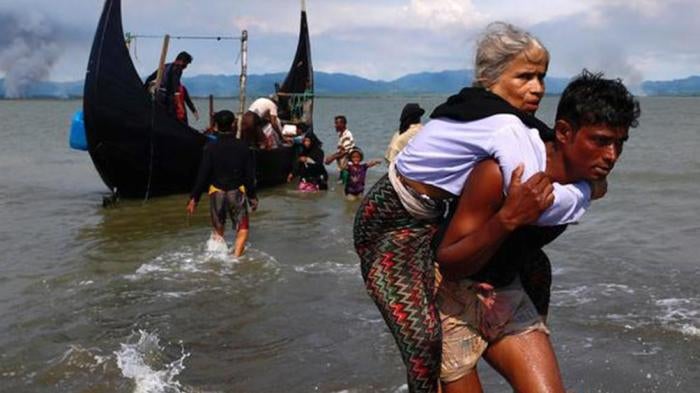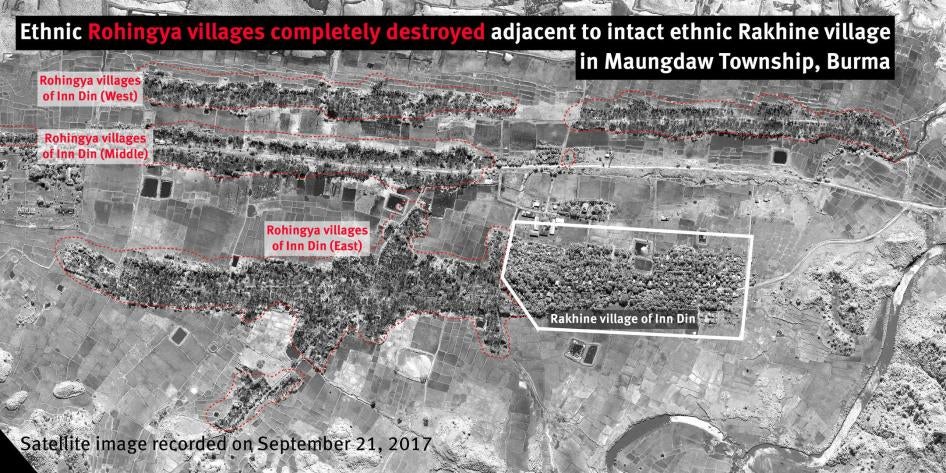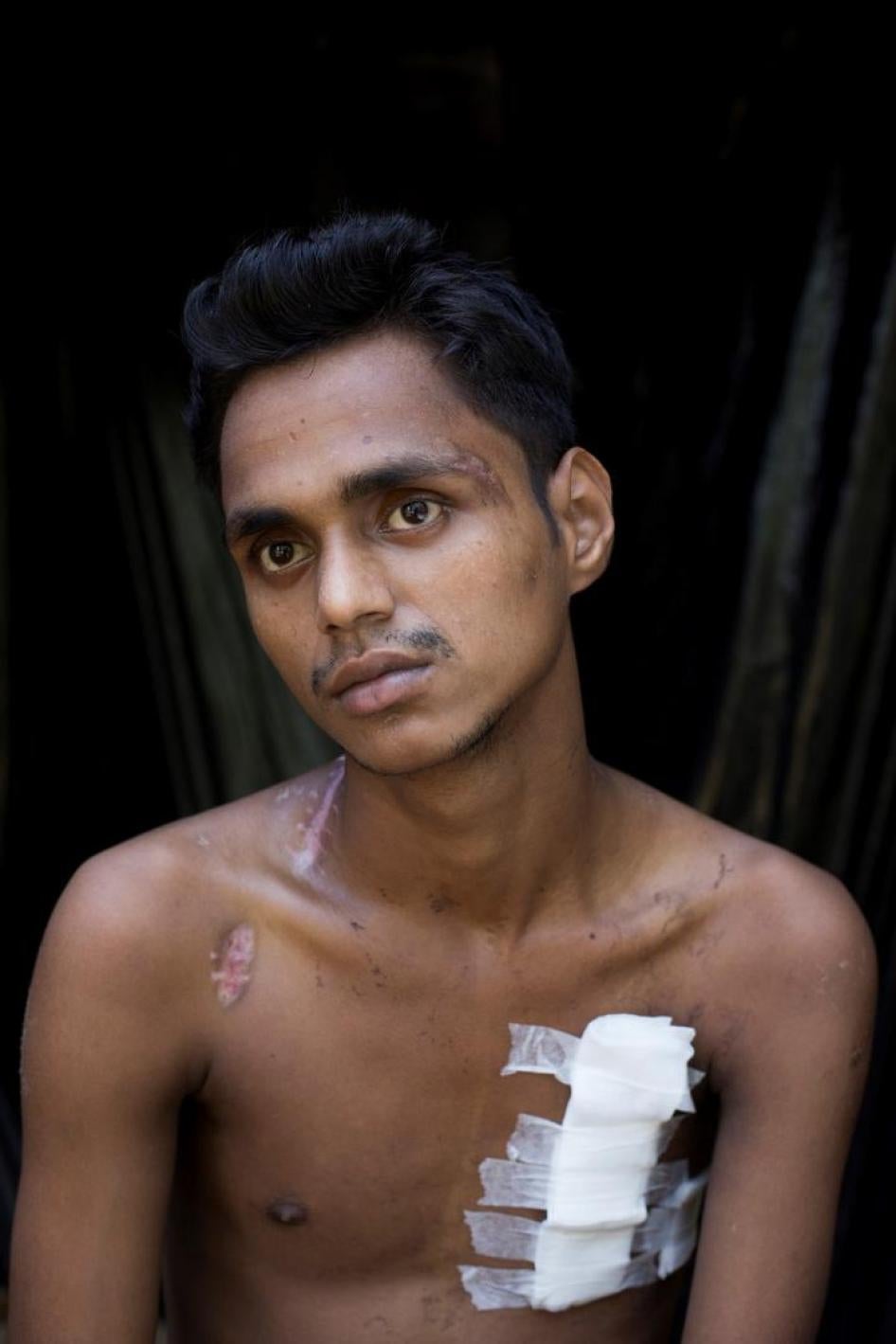
Rohingya Crisis

Since August 25, Burmese security forces have been carrying out a campaign of ethnic cleansing against Rohingya Muslims in Rakhine State. Over half a million Rohingya have fled to neighboring Bangladesh to escape killings, arson, and other mass atrocities. The Rohingya, effectively denied citizenship under Burmese law, have faced decades of repression and discrimination. About 120,000 remain internally displaced from waves of violence in 2012 and 2016, in dire humanitarian conditions. Human Rights Watch researchers are reporting from the field on the crisis and its global impact.
Military’s Use of Rape for Ethnic Cleansing
“They dragged me out of the house and raped me under a tree. This is where they dragged me” #RohingyaCrisis pic.twitter.com/IrvkAkPYlh
— Skye Wheeler (@WheelerSkye) October 15, 2017
Skye Wheeler, emergencies researcher for the Women’s Rights Division, has been documenting rape survivors’ stories in the Rohingya refugee camps. “The Burmese military has clearly used rape as one of a range of horrific methods of ethnic cleansing against the Rohingya,” she told Reuters. “Rape and other forms of sexual violence has been widespread and systematic as well as brutal, humiliating, and traumatic.”
In early September, Rakhine State minister for border security, Col. Phone Tint, denied reports of military abuses, specifically sexual violence. “Where is the proof?” he asked. “Look at those women who are making these claims – would anyone want to rape them?”
The military’s denials are not new. In December 2016, the Burmese government contested reports of the military’s use of sexual violence in a press release published under the headline, “Fake Rape.” Human Rights Watch and other groups documented widespread rape and other sexual violence by security forces during the military operations starting last October.
Read the full report, “Burma: Security Forces Raped Rohingya Women, Girls” (February 2017) >>
Satellite Imagery Disproves Government Claims
Myanmar ethnic cleansing of Rohingya over? Don't believe a word of it. Long line waiting to cross border yesterday. https://t.co/DV9Fhok6fq pic.twitter.com/cBDwY8va5k
— Kenneth Roth (@KenRoth) October 17, 2017
I would like to reaffirm that violence has subsided in northern Rakhine and operations by security forces have ceased since 5 September.
However, Human Rights Watch’s analysis of satellite imagery shows that at least 66 villages were burned after September 5.
“We don’t believe those operations did stop,” Phil Robertson, deputy Asia director, told the New York Times. “The narrative pushed by the military and Aung San Suu Kyi on the clearance operations is patently false.”
On Sunday night and Monday, 10,000 to 15,000 more Rohingya refugees arrived in Bangladesh at the Anjuman Para crossing. Aerial footage from UNHCR shows thousands crossing the border, stranded inside Bangladesh while waiting for permission to travel further. Many said they had walked for about a week, fleeing the violence and humanitarian crisis in Rakhine State. They said they had initially stayed despite threats, but were later forced to flee when their villages were also burned, according to the UN refugee agency.
Shamina
Shamina gave birth to her daughter, Sharmin, in a forest after fleeing a Burmese army attack on her village. When her water broke, Shamina had been walking for four days without food or water. She was in labor through the night. Another woman fleeing the attacks used a thorn from forest brush to cut Sharmin’s umbilical cord. It took another 10 days for them to reach Bangladesh.
288 Villages, Tens of Thousands of Structures Torched
The most damage occurred in Maungdaw Township, accounting for approximately 90 percent of the areas destroyed between August 25 and September 25. In many places, satellite imagery showed multiple areas on fire, burning simultaneously over wide areas for extended periods.
Read the full report >>
Ask HRW: Flight of the Rohingya
In a Facebook live event, Human Rights Watch’s Rich Weir discusses his work spent on the Bangladesh-Burma border over the past weeks documenting the Burmese military’s campaign of ethnic cleansing and crimes against humanity.
New Military Investigation Underway
On Friday, the Tatmadaw True News Information Team announced a military-led investigation into the role of security forces in the Rakhine State crisis. The announcement, posted on commander-in-chief Sr. Gen. Min Aung Hlaing’s Facebook page, named Lt. Gen. Aye Win as head of the investigation.
Earlier this year, Lt. Gen. Aye Win led the army’s investigation into military abuses in Rakhine State since October 2016. Human Rights Watch documented serious abuses committed by the military during that period, including extrajudicial killings, rape and other sexual violence, and widespread arson. In May, the army’s investigation team announced that they had uncovered no security force wrongdoing aside from two minor incidents. They also concluded that the allegations against the army in a report by the UN Office of the High Commissioner for Human Rights were either “totally wrong” or “found to be untrue due to false accusations and exaggerations.”
To read the full release on the prior investigation >>
Reports of Sexual Violence
Human Rights Watch researchers on the border continue to document reports of rape and other sexual violence committed by Burmese soldiers against Rohingya women and girls. Skye Wheeler, emergencies researcher for the Women’s Rights Division, shares some of their stories.
“Soon after they raped me I had a miscarriage. There was blood everywhere. Neighbors carried me to the safety of the jungle” #RohingyaCrisis
— Skye Wheeler (@WheelerSkye) October 12, 2017
“The Myanmar military took my husband away. Then they raped me. I found him again in the jungle. But I can’t tell him.” #RohingyaCrisis pic.twitter.com/Nbh2icD2ib
— Skye Wheeler (@WheelerSkye) October 12, 2017
One woman, still bearing injuries from her attack, described to Human Rights Watch how she was raped, beaten, and slashed with machetes by soldiers, before being left in a burning house. Another woman was taken to a hut with four others and sexually assaulted by soldiers, who then set the building on fire. She was the only one to escape to alive. Survivors of the massacre in Maung Nu village described how soldiers stripped women naked and “touched [them] everywhere.”
"It was two days after the rapes that I could begin walking." #Rohingya pic.twitter.com/Bq691Q6xEl
— Skye Wheeler (@WheelerSkye) October 4, 2017
#RohingyaCrisis camps are chaos for the woman we talked to: survived gang rape, 10 days walk to safety, pain, infection can't find a clinic
— Skye Wheeler (@WheelerSkye) October 4, 2017
“We’re seeing pretty widespread rape and sexual assault on women,” Peter Bouckaert, emergencies director, told Al Jazeera. “In my 20 years working at Human Rights Watch, these are some of the most shocking and horrific abuses that I have documented. They really bring back memories of the genocide in Rwanda in terms of the level of hatred and extreme violence shown – especially towards women and children.”
Interviewed three women say they can't talk to doctor about rape as the clinics are heaving with people. "Too much shame" #RohingyaCrisis
— Skye Wheeler (@WheelerSkye) October 4, 2017
#rohingyacrisis rape survivors saying they have not been to camp clinic: assume they can’t afford it: whole lives denied basic services
— Skye Wheeler (@WheelerSkye) October 8, 2017
Hundreds of refugees have been referred to health clinics in Cox’s Bazar for “life-saving care” due to injuries from gender-based violence. Yet these likely represent only a small number of the survivors of sexual violence among the 520,000 Rohingya refugees who have fled to Bangladesh since late August. As the United Nations migration director general said in a recent statement:
Attempting to understand the scale of gender-based violence through known case numbers alone is impossible. This type of egregious violence and abuse is under-reported even in the best resourced and most stable settings worldwide. In crises like this, where usual social systems and protections are no longer in place, so many barriers stand in the way of survivors seeking support.
Incredible pain walking days after gang rapes. One interviewer said the word pain and burst into tears remembering #RohingyaCrisis pic.twitter.com/mxF2qlYo8s
— Skye Wheeler (@WheelerSkye) October 8, 2017
Mass rape gang rape slicing babies beating mums and dads to death - Burma army wanted survivors traumatized for life #RohingyaCrisis
— Skye Wheeler (@WheelerSkye) October 11, 2017
Early days for humanitarian response for #RohingyaCrisis but Rohingya communities need careful support to begin planning for managing trauma
— Skye Wheeler (@WheelerSkye) October 11, 2017
Widespread sexual violence by soldiers has long been a hallmark of the Burmese military’s culture of abuse and impunity. During the “clearance operations” in Rakhine State in late 2016, security forces committed rape and other sexual violence against ethnic Rohingya women and girls as young as 13. Human Rights Watch documented 28 incidents of rape and other sexual assault that took place from October to December. The sexual violence did not appear to be random or opportunistic, but part of a coordinated and systematic attack against the Rohingya population. More than half of the 101 women UN investigators interviewed for a February OHCHR report said they were raped or suffered other forms of sexual violence.
Interviewed several women who faced weeks of sexual harassment and looting by military before villages burned #rohingyacrisis
— Skye Wheeler (@WheelerSkye) October 8, 2017
Women interviewees say they have nothing now but the clothes they’re in but so relieved to be here “I sleep now” #RohingyaCrisis
— Skye Wheeler (@WheelerSkye) October 8, 2017
Food Lines
Rohingya refugees wait in line for food rations at one of the World Food Programme distribution sites in Kutupalong refugee camp, Bangladesh. Over 10,000 new refugees crossed the border on Monday.
Useful map of where half a million people have arrived in the last weeks #RohingyaCrisis pic.twitter.com/uutmXUg5sA
— Skye Wheeler (@WheelerSkye) October 8, 2017
Karima
Karima Khatun, 21, survived a massacre in her village in Rakhine State. Her 2-year-old son, Mohammed Anas, was wounded when an RPG landed in their yard. Karima ran with him in her arms to a nearby paddy field to escape the attack by Burmese soldiers. There, Mohammed and Karima were struck by the same bullet, which tore through Mohammed’s abdomen and into Karima’s arm. She tried to bandage his torso with a scarf but Mohammed died as she held him. Karima also lost her husband and brother that day.
Massacre in Maung Nu
The Burmese military summarily executed several dozen Rohingya Muslims in Maung Nu village in Burma’s Rakhine State on August 27. Witnesses told Human Rights Watch that Burmese soldiers had beaten, sexually assaulted, stabbed, and shot villagers who had gathered for safety in a residential compound.
Muhamedul Hassan, 18, said that a dozen soldiers took him and two male relatives from their house to a nearby courtyard. He said that when they got there, there were hundreds of men and boys tied up:
Four soldiers took us to the corner of the courtyard and shot us each twice in the back. I lost consciousness. When I woke up, I saw many men still tied. [The soldiers] were still killing people. Many were stabbed to death. When I tried to flee I was shot in the chest but was able to escape.
Muhamedul showed Human Rights Watch his bullet wounds. He said that in addition to the two executed beside him, nearly 30 more male relatives were killed that day.
Satellite imagery analyzed by Human Rights Watch shows the near total destruction of the villages of Maung Nu and nearby Hpaung Taw Pyin.

